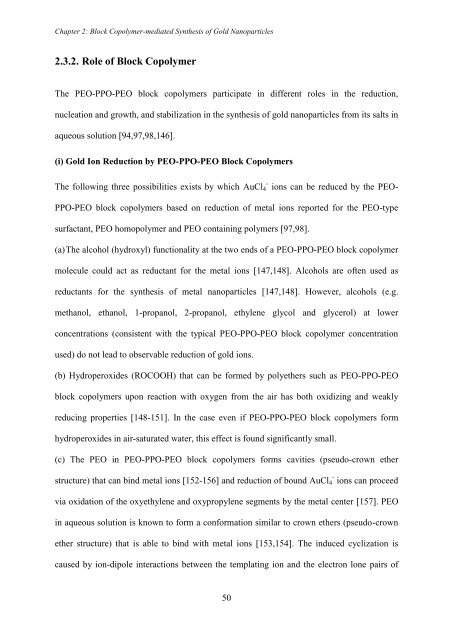PHYS01200704032 Debes Ray - Homi Bhabha National Institute
PHYS01200704032 Debes Ray - Homi Bhabha National Institute
PHYS01200704032 Debes Ray - Homi Bhabha National Institute
You also want an ePaper? Increase the reach of your titles
YUMPU automatically turns print PDFs into web optimized ePapers that Google loves.
Chapter 2: Block Copolymer-mediated Synthesis of Gold Nanoparticles<br />
2.3.2. Role of Block Copolymer<br />
The PEO-PPO-PEO block copolymers participate in different roles in the reduction,<br />
nucleation and growth, and stabilization in the synthesis of gold nanoparticles from its salts in<br />
aqueous solution [94,97,98,146].<br />
(i) Gold Ion Reduction by PEO-PPO-PEO Block Copolymers<br />
The following three possibilities exists by which AuCl - 4 ions can be reduced by the PEO-<br />
PPO-PEO block copolymers based on reduction of metal ions reported for the PEO-type<br />
surfactant, PEO homopolymer and PEO containing polymers [97,98].<br />
(a) The alcohol (hydroxyl) functionality at the two ends of a PEO-PPO-PEO block copolymer<br />
molecule could act as reductant for the metal ions [147,148]. Alcohols are often used as<br />
reductants for the synthesis of metal nanoparticles [147,148]. However, alcohols (e.g.<br />
methanol, ethanol, 1-propanol, 2-propanol, ethylene glycol and glycerol) at lower<br />
concentrations (consistent with the typical PEO-PPO-PEO block copolymer concentration<br />
used) do not lead to observable reduction of gold ions.<br />
(b) Hydroperoxides (ROCOOH) that can be formed by polyethers such as PEO-PPO-PEO<br />
block copolymers upon reaction with oxygen from the air has both oxidizing and weakly<br />
reducing properties [148-151]. In the case even if PEO-PPO-PEO block copolymers form<br />
hydroperoxides in air-saturated water, this effect is found significantly small.<br />
(c) The PEO in PEO-PPO-PEO block copolymers forms cavities (pseudo-crown ether<br />
structure) that can bind metal ions [152-156] and reduction of bound AuCl - 4 ions can proceed<br />
via oxidation of the oxyethylene and oxypropylene segments by the metal center [157]. PEO<br />
in aqueous solution is known to form a conformation similar to crown ethers (pseudo-crown<br />
ether structure) that is able to bind with metal ions [153,154]. The induced cyclization is<br />
caused by ion-dipole interactions between the templating ion and the electron lone pairs of<br />
50

















